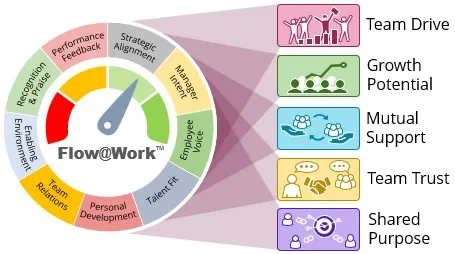
The current discourse on team effectiveness has evolved significantly, reflecting a shift from earlier factor-based approaches to more multi-level and dynamic frameworks that better account for the complexity of team dynamics in contemporary organisations. The extant literature on team effectiveness in organisations reflects a rich and multidimensional discourse, converging around key themes of trust, communication, cognitive alignment, and adaptability, while also diverging in emphasis on specific mechanisms and contexts. Research has consistently affirmed that team effectiveness is an outcome of complex interplays between individual competencies, collective processes, and emergent states, each influenced by contextual and organisational variables.
Research suggests that trust serves as the cornerstone of alignment and cohesion among team members. Interpersonal trust reinforces members’ confidence and dignity within the team, which is necessary for the team’s ability to navigate challenges without undermining cohesion. Team cohesion, in turn, is central to enhancing the collaboration and collective effort necessary for teams to manage conflict effectively and sustain focus on organisational goals. More recently, these fairly diverging themes of trust, cohesion, conflict, and goal attainment have been harmonised in the concept of ‘psychological safety’. Psychological safety is defined as a perception of reduced interpersonal risk, within work environments, where individuals feel able to express themselves candidly, share ideas, ask questions, and take interpersonal risks without fear of negative consequences. The presence of psychological safety has been shown to promote collaborative environments, which in turn supports team learning behaviours and efficacy.

The existing literature on team effectiveness also offers insights into the mechanisms that underpin the pro-social group behaviours and phenomena such as psychological safety. Individual team members’ emotional intelligence serves as a key enabler in sustaining enthusiasm and commitment within teams. Furthermore, individual motivational drivers influence how people derive satisfaction and stimulation from their team membership. Beyond individual characteristics, relational processes, including both emotional and practical assistance, particularly during high-demand periods, have also been linked to highly effective teams. Shared leadership within teams has been shown to contribute to healthy team dynamics by empowering individuals to leverage their unique expertise towards collaborative efforts. Together, interpersonal and relational factors highlight the interdependence of team members and the quality of their interactions as critical components of team effectiveness.
Finally, the capacity for growth and adaptation reflects the culmination of effective team functioning. Team learning behaviours, such as reflecting, experimenting, and seeking feedback, enable continuous improvement and adaptability to changing circumstances. Leadership approaches that prioritise development, such as servant leadership, have been shown to be instrumental in creating environments where members feel supported in their growth. Continuous development and leader-facilitated adaptive behaviours enhance team effectiveness, as they enable members to respond effectively to complex and evolving organisational challenges.
Note: please contact us if you want a research-backed version of the article with full academic references
